Search blog
IELTS Listening Test Format & Tips to Achieve Maximum Score
Listening is one of the "easier" skills in the IELTS exam. To effectively prepare and achieve a high band score, it is essential to have a thorough understanding of the IELTS Listening test format. How many sections does the Listening test consist of? What kind of knowledge can appear in the actual exam? Let's explore the IELTS Listening test format in detail through the following article on prepedu.com!
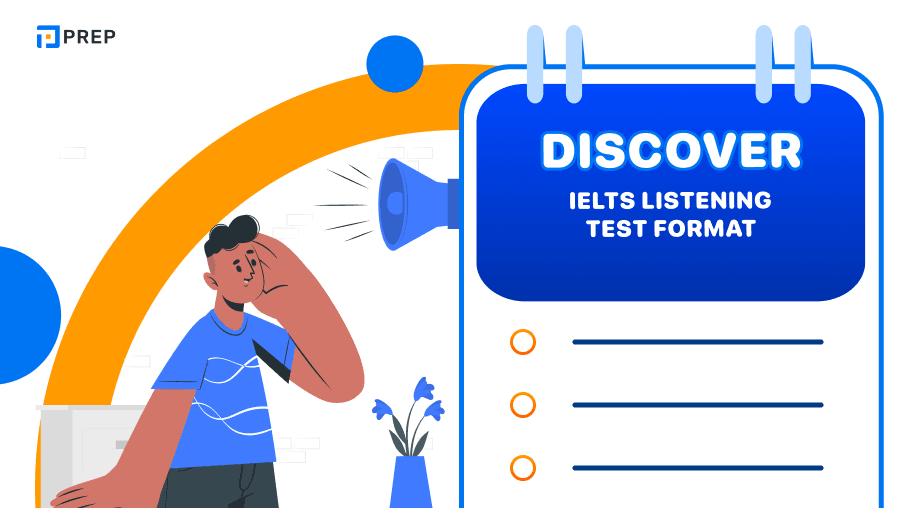
I. Detailed format of IELTS Listening Test

The total time allotted for the IELTS Listening exam is 30 minutes. For the paper-based IELTS Listening test, you will have an additional 10 minutes to transfer your answers to the Answer Sheet. However, if you take the Listening test online via computer, you will only have 2 minutes to review your answers.
The IELTS Listening test format consists of 4 parts with increasing difficulty. Each part contains 10 questions, resulting in a total of 40 questions. Each question carries 1 point. The test format for both IELTS Academic and IELTS General Training is identical.
Be cautious when reading the instructions regarding the allowed number of words in the answers, as some instructions specify that you should write only one word, two words, a specific number, etc. Additionally, you need to develop the ability to analyze the questions and have a rich vocabulary, especially for synonyms, as the vocabulary used in the listening passage may differ from that in the questions and sometimes they are paraphrased.
To effectively prepare for the exam and achieve a high score in the Listening section, it is crucial to have a solid understanding of the IELTS Listening test format. Refer to the table below to familiarize yourself with the IELTS Listening Test Format:
Part | Detail |
IELTS Listening Part 1 | The IELTS Listening Test Format - Part 1 will be a conversation between two people revolving around everyday life topics. For example, booking hotel rooms, crime report forms, student accommodation registration forms, etc. |
IELTS Listening Part 2 | The IELTS Listening Test Format - Part 2 will be a monologue characteristic of daily life. For example, a conversation about effective time management, a presentation about a museum, etc. |
IELTS Listening Part 3 | The IELTS Listening Test Format - Part 3 will be a conversation among 3 or 4 people on an educational or training topic. For example, students discussing an assignment, students and professors discussing a specific subject, etc. |
IELTS Listening Part 4 | The IELTS Listening Test Format - Part 4 will be a monologue related to academic topics, the environment, etc. For example, a university lecture, environmental conservation, etc. |
II. Types of Questions in the IELTS Listening Exam
1. Multiple Choice Questions
In the IELTS Listening Test Format, there is usually a section for multiple choice questions. These multiple choice questions can fall into one of two types:
- Multiple choice questions with one answer.
- Multiple choice questions with two or more answers.

To achieve a high band score when encountering these questions, test takers need to listen carefully to accurately identify all the answers from the options provided in the question. When answering multiple choice questions, you should pay attention to:
- Read the question and the answer choices carefully, especially information about dates, months, or years.
- The information provided in the IELTS Listening exams may not follow the order of the questions in the audio. Therefore, to answer accurately, you need to listen to the entire set of questions to determine the topic being referred to.
- The vocabulary used in the questions is often replaced with synonyms in the audio or interpreted in different ways.
- The audio in the IELTS Listening exams provides various types of information, which can be confusing. Therefore, do not rush to write down the answer but listen to the entire audio attentively.
2. Map Location Questions
Map location questions often appear in the structure of the IELTS Listening Part 2. For this type of question, the exam provides a map, and the task for the test taker is to listen to the audio and match the given locations with their positions on the map. There are two types of these questions as follows:
- The exam provides a list of words to fill in the blanks on the map. Test takers need to listen and choose the correct words to fill in the gaps on the map.
- No list is provided, and test takers have to listen to the audio and determine the locations to fill in the map themselves.
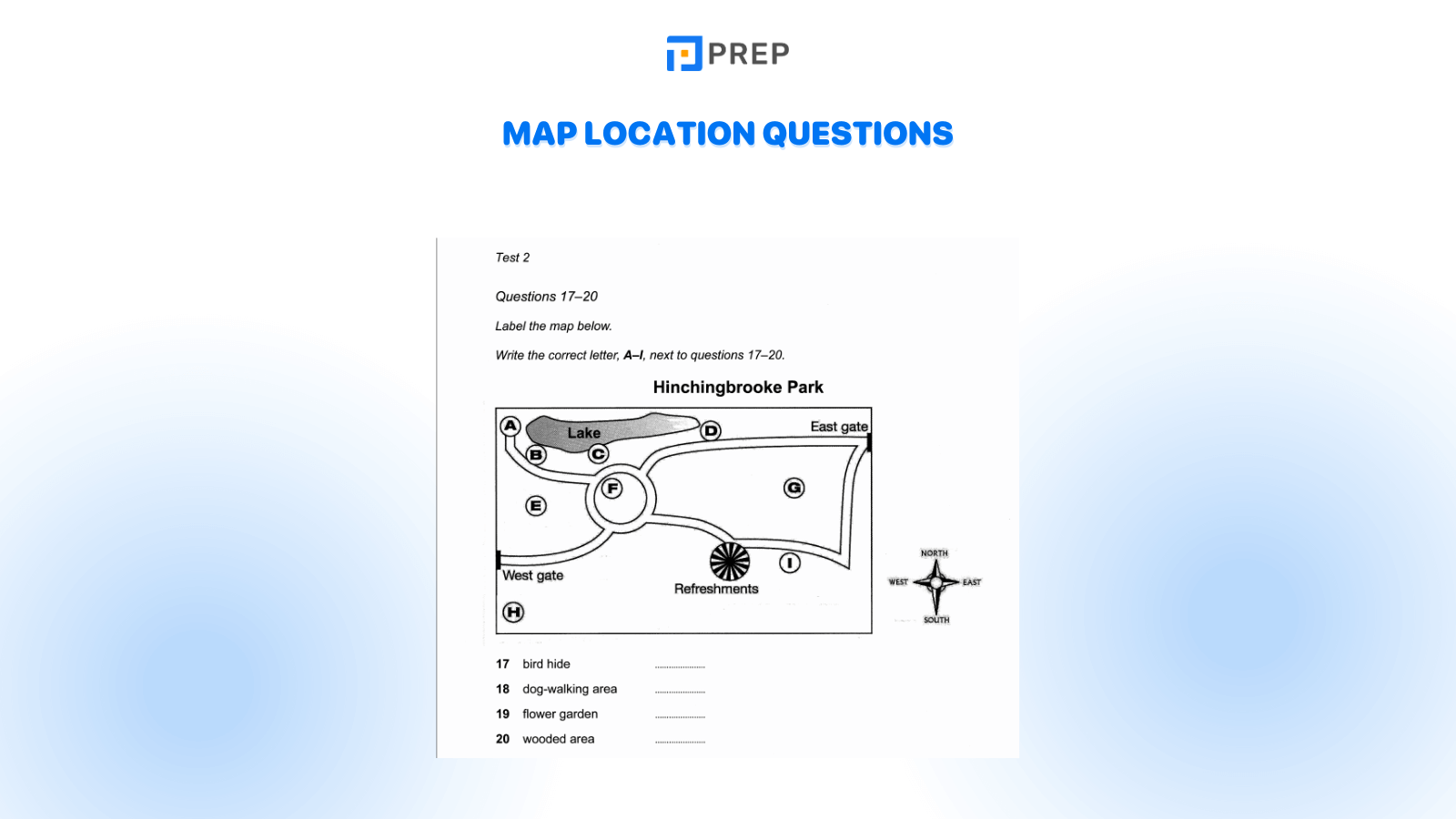
To understand the IELTS Listening Test Format and achieve a high band score, you need to take note of the following:
- Read and study the questions in the task to know the word limit for filling in the blanks and how many gaps there are.
- There will be instructions for a specific place or certain types of trips, so pay close attention to the audio.
- Listen carefully to the descriptions surrounding the given location in the task. For example, next to the supermarket, below the park, etc.
- Pay attention to the question in the IELTS Listening Test Format, and then determine the orientation of the map. This helps you listen to what is going to happen more accurately.
3. Completion Questions
Completion questions can include:
- Sentence completion
- Note completion
- Table completion
- Diagram completion
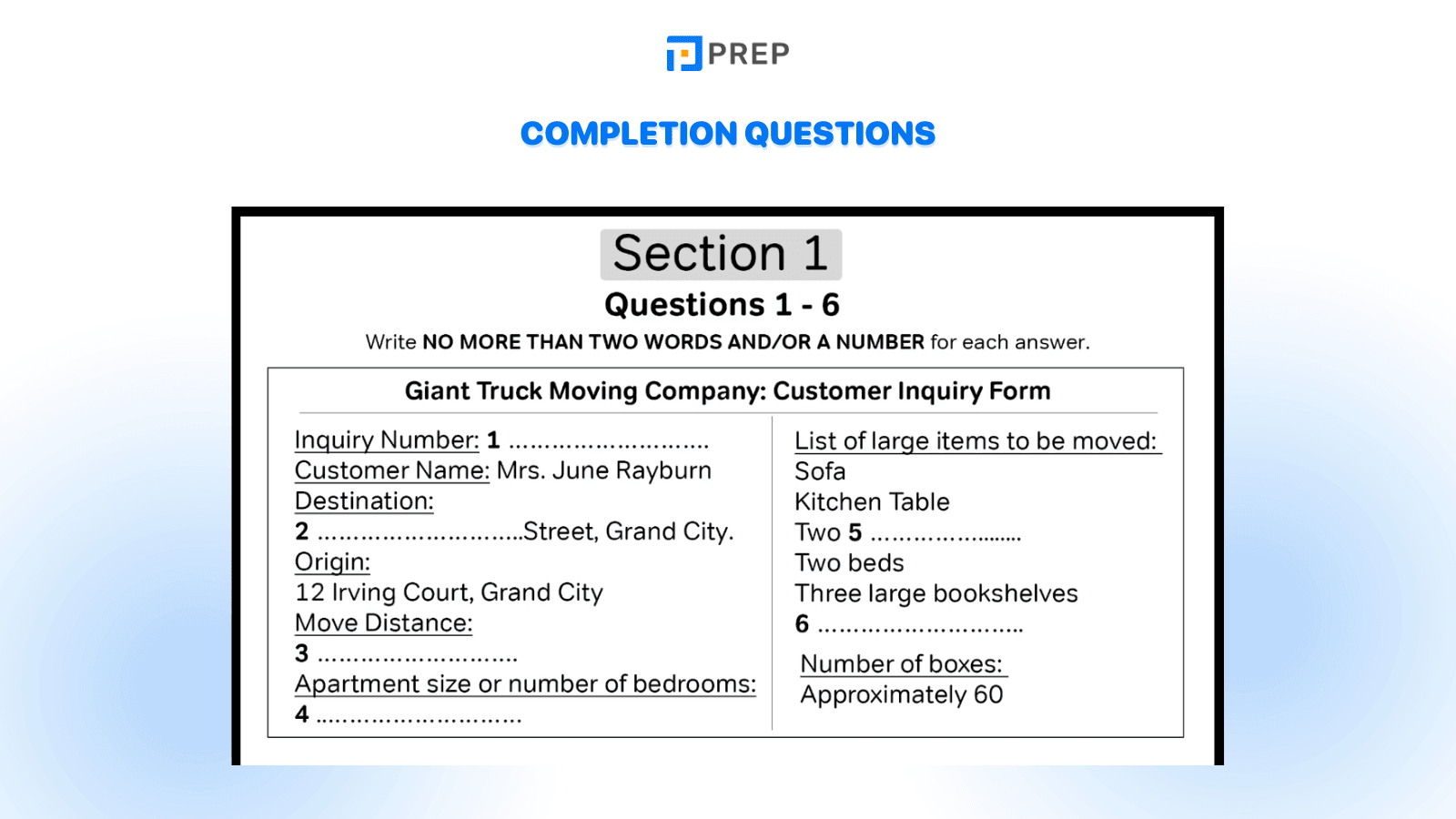
To understand the IELTS Listening Test Format and excel in completing the completion questions, you need to pay attention to the following:
- Read and study the questions in the task carefully before you start to understand the audio.
- Predict what will be filled in the blanks, such as a specific location, a certain number, a particular year, a name, or even a range of specific information. Base your predictions on the vocabulary before and after the blank.
- The answers you fill in the answer sheet must be the exact words that appear in the listening passage.
- Remember to carefully check the word count, spelling, and grammar before transferring your answers to the answer sheet.
4. Information Matching Questions
Information matching questions are less common than the previous types, but they occasionally appear in the IELTS Listening Test Format. For this type of question, the task provides a list of answers, and your task is to listen and match them with the audio together as accurately as possible.
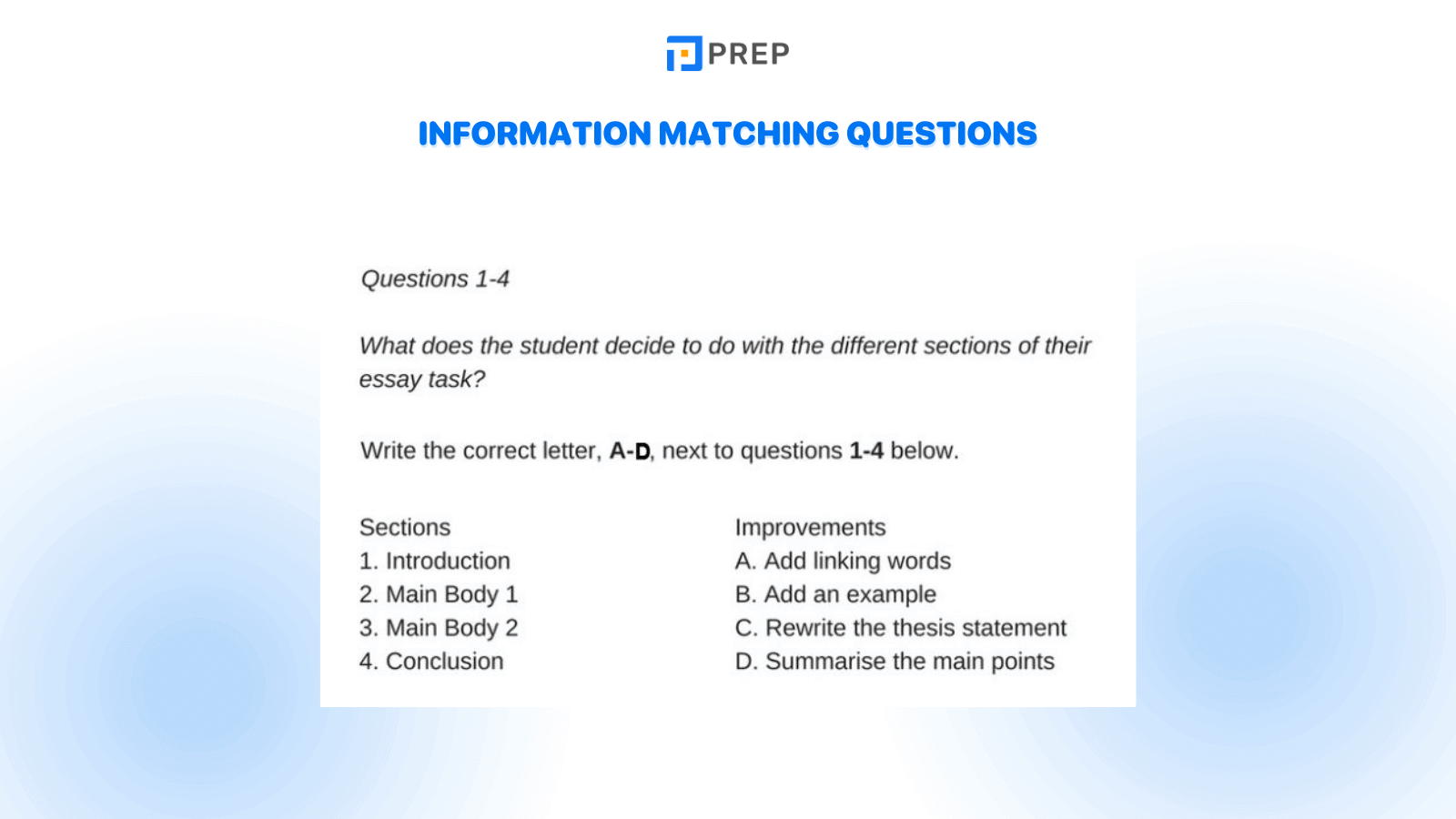
To achieve a 100% score in this type of question, test takers should take the opportunity to look at all the answers in the task before listening to the audio. This helps you have a better overview of the information. Moreover, writing down all the relevant information will make it easier for you to find the answers quickly and accurately.
III. IELTS Listening Scoring
The IELTS Listening Test Format will consist of 40 questions. These 40 questions will be divided into 4 parts to assess the test taker's listening skills. The IELTS Academic and IELTS General exams not only have similar test formats, but the scoring methods for both sections are also the same. If you want to achieve a band score of 6.0 in the Listening skill, you must answer correctly 23-26 questions. Below is the standard IELTS Listening scoring scale.
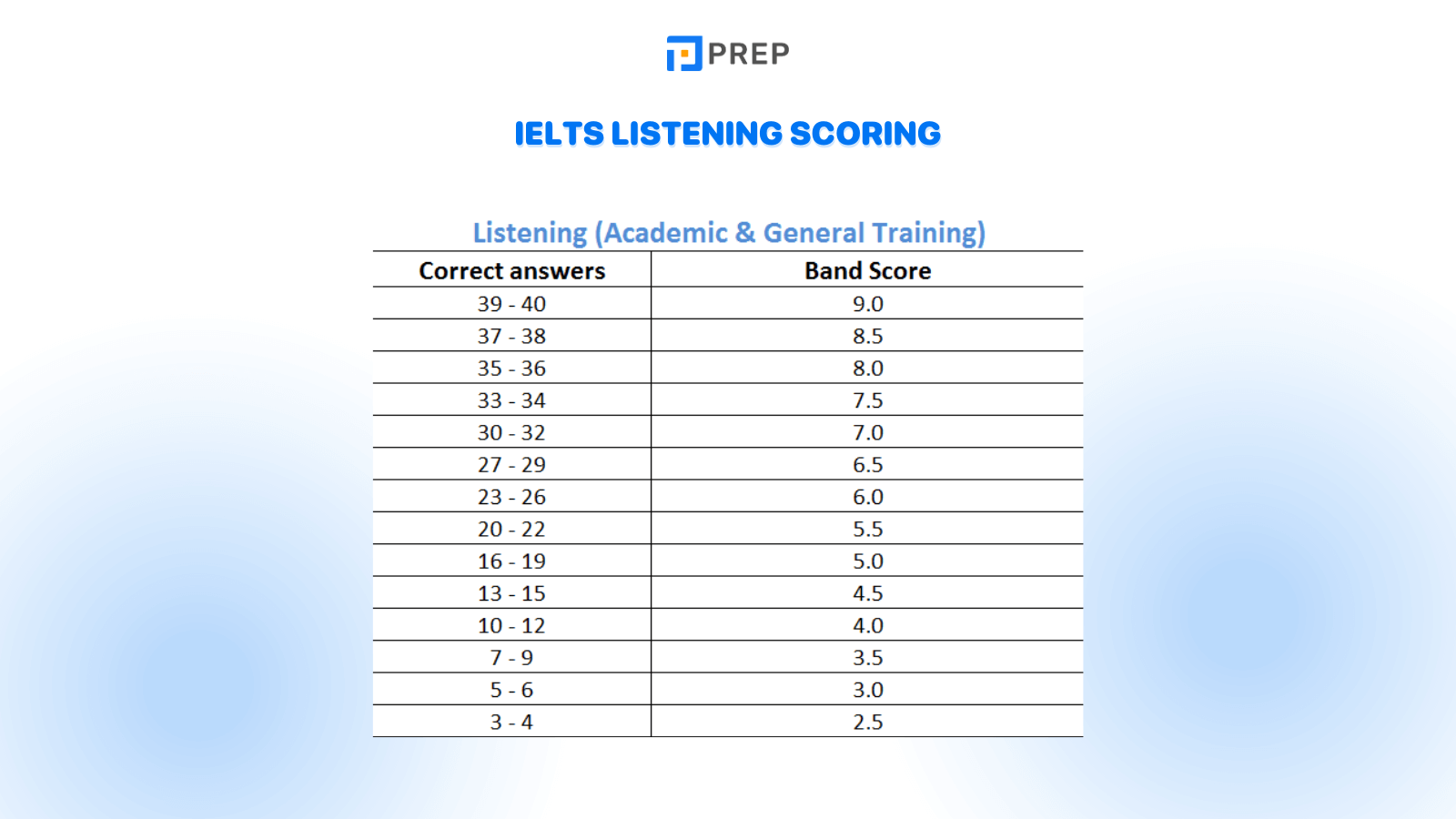
IV. Effective Tips for IELTS Listening Preparation

1. Practicing Listening for the IELTS Listening Exam at Home
Apply the following 9 steps to practice listening for the IELTS Listening exam using Cambridge books or real practice tests:
- Step 1: Listen once and do the exercise.
- Step 2: Listen again and write down your answers to easily compare the number of correct answers between the two times.
- Step 3: Check the answers and the script - here, many people only check the answers to see how many they got right, but it is especially important to review the script for better listening comprehension. From there, you can understand why you made mistakes or missed information (due to vocabulary gaps, incorrect pronunciation, or poor listening comprehension speed).
- Step 4: Listen again to the parts where you made mistakes or missed information to avoid similar issues in the future.
- Step 5: Practice shadowing with the script you just reviewed - I will talk more about shadowing skills below!
- Step 6: Take note of the useful expressions in the script that you can apply to yourself - for example, if you did Listening Test 2 - Section 2 - Cambridge 15, after reviewing the script, you may find the structure "carry out a major refurbishment." "Refurbishment" means renovation, and you find it a useful expression to talk about houses, so you write it down for use in the Speaking test as well.
- Step 7: Practice pronouncing accurately by imitating the sentences that contain the identified structures.
- Step 8: Practice constructing sentences using the identified expressions that are suitable for yourself, to understand how to use and apply them during Speaking - create sentences using the previously identified structure like this: "Our family have decided to carry out a major refurbishment to our house to modernize the living space and arrange some new furniture."
- Step 9: Incorporate the identified expressions into corresponding IELTS Speaking topics.
2. Practicing Listening with Supplementary Resources for IELTS Listening
In addition to practicing listening with Cambridge books or official IELTS Listening practice tests, you can listen to audio on YouTube, and TED-Talks to improve your listening skills. Here are some steps to follow:
- Step 1: Watch it once to enjoy and understand the content. You can turn on Vietnamese subtitles because learning is much more effective when we understand and enjoy the content we are studying.
- Step 2: Watch it again, trying to listen as much as possible (turn off Vietnamese subtitles).
- Step 3: Listen and re-listen to the parts you missed 2-3 times, trying to catch as much as possible. If not, move on.
- Step 4: Check the full English script of the video (you can use the "Language Learning with YouTube" extension on Google Chrome to display captions for YouTube videos, turn on Closed Caption, or use Google to find the corresponding script).
- Step 5 - Step 9: Similar to the steps above.
Not only the IELTS Listening Test Format, the IELTS test requires test takers to comprehensively improve all 4 skills. It can be challenging to learn, evaluate your results, or recognize your mistakes on your own. Therefore, if you have the opportunity, consider taking additional IELTS courses at PREP. PREP is a reputable and high-quality English and IELTS test preparation center!

Comment
Search blog
Đăng ký tư vấn lộ trình học
Bạn hãy để lại thông tin, Prep sẽ liên hệ tư vấn cho mình ngay nha!
